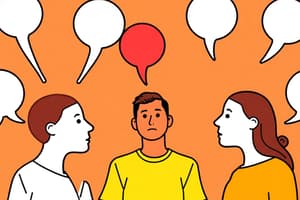Podcast
Questions and Answers
What is the term used to describe when exposure to socially relevant stimuli influences impressions, judgments, goals, and actions?
What is the term used to describe when exposure to socially relevant stimuli influences impressions, judgments, goals, and actions?
- Social priming (correct)
- Social divergence
- Social observation
- Social inference
How can an individual's actions be affected in a social environment?
How can an individual's actions be affected in a social environment?
- Only by their emotional state
- By the beliefs they hold exclusively
- Only by their personality traits
- By both internal states and situational constraints (correct)
What effect did positive primes have in the study related to impression formation?
What effect did positive primes have in the study related to impression formation?
- Led to neutral descriptions of behavior
- Had no effect on judgment
- Led to negative perceptions of personality
- Led to positive descriptions of personality (correct)
What was the primary focus of the study related to priming social norms?
What was the primary focus of the study related to priming social norms?
What was the outcome for participants who were exposed to an image of a library before a task?
What was the outcome for participants who were exposed to an image of a library before a task?
In the context of negotiation and impression formation, what role do agents have?
In the context of negotiation and impression formation, what role do agents have?
What is required to infer the attributes of agents in a social environment?
What is required to infer the attributes of agents in a social environment?
What cognitive process assists individuals in interpreting ambiguous social situations?
What cognitive process assists individuals in interpreting ambiguous social situations?
Which term describes the inherent attributes that agents possess but cannot be directly perceived?
Which term describes the inherent attributes that agents possess but cannot be directly perceived?
What impact does social priming have on participant behavior when related to norms?
What impact does social priming have on participant behavior when related to norms?
What does business priming tend to increase in individuals?
What does business priming tend to increase in individuals?
What is the fundamental attribution error?
What is the fundamental attribution error?
Which stage of attribution is described as requiring little cognitive effort?
Which stage of attribution is described as requiring little cognitive effort?
What effect does cognitive load have on attributions?
What effect does cognitive load have on attributions?
What is one potential downside of the automatic activation of social knowledge?
What is one potential downside of the automatic activation of social knowledge?
Which statement reflects the actor-observer error?
Which statement reflects the actor-observer error?
Participants in studies often do not realize the connection between which two tasks?
Participants in studies often do not realize the connection between which two tasks?
What characterizes social environments according to the studies discussed?
What characterizes social environments according to the studies discussed?
What is social priming often used to influence?
What is social priming often used to influence?
How is the process of making personal attributions described?
How is the process of making personal attributions described?
Flashcards
Social Priming
Social Priming
Exposure to socially relevant stimuli influences impressions, judgments, goals, and actions.
Social Environment Complexity
Social Environment Complexity
Social environments involve individuals with unique goals, motivations, and hidden traits, making interactions ambiguous and challenging to interpret.
Social Priming in Impression Formation
Social Priming in Impression Formation
Exposure to certain traits (like 'adventurous' or 'reckless') can bias our judgments of others.
Social Priming in Norm Activation
Social Priming in Norm Activation
Signup and view all the flashcards
Social Priming in Situational Ambiguity
Social Priming in Situational Ambiguity
Signup and view all the flashcards
Social Judgments
Social Judgments
Signup and view all the flashcards
Attributions
Attributions
Signup and view all the flashcards
Situational Constraints
Situational Constraints
Signup and view all the flashcards
Inferring Attributes
Inferring Attributes
Signup and view all the flashcards
Navigating Uncertainty
Navigating Uncertainty
Signup and view all the flashcards
Priming and Competition
Priming and Competition
Signup and view all the flashcards
Fundamental Attribution Error
Fundamental Attribution Error
Signup and view all the flashcards
Actor-Observer Error
Actor-Observer Error
Signup and view all the flashcards
Two-Stage Attribution Theory
Two-Stage Attribution Theory
Signup and view all the flashcards
Cognitive Load
Cognitive Load
Signup and view all the flashcards
Social Environments
Social Environments
Signup and view all the flashcards
Spreading Activation
Spreading Activation
Signup and view all the flashcards
Automatic Retrieval of Memory
Automatic Retrieval of Memory
Signup and view all the flashcards
Study Notes
Learning and Memory in a Social World (Lecture 19)
- Social environments are complex, often ambiguous, populated by agents with individual goals, motivations, internal states (beliefs, emotions), and latent attributes (personality).
- Agents interact; trying to influence behavior or beliefs (e.g., negotiation, impression formation, reputation management).
- Agents' attributes are inferred from actions, but actions are affected by situational constraints. The same person may act differently in different situations.
- Social situations are sometimes uncertain; people use past knowledge to interpret new situations or to fill in the gaps, to understand/relate new situations to past experience.
Social Priming
- Social priming: exposure to socially relevant stimuli influencing impressions, judgments, goals, and actions.
- Social priming is a general memory phenomenon (priming) applied to social concepts.
- Priming influences impression formation, activation of behavioral norms, and attributions.
- Studies show prior exposure to trait adjectives influences judgments of other behaviors. Participants primed with positive adjectives (e.g., adventurous) had more positive judgments than those primed with negative adjectives (e.g., stubborn).
- Priming can also influence social norms. (e.g, Participants primed with business-related images judged situations as more competitive.)
Social Priming: Attributions
- Attributions are explanations of behaviors—personal or situational.
- Fundamental attribution error: tendency to attribute behavior to personality rather than situation.
- Actor-observer bias: People attribute behaviors of others due to personality factors, but their own behavior due to specific situational factors.
- Two-stage theory of attribution: First stage is automatic & personal; Second stage is slower and considers the situation.
Priming Manipulation
- Priming manipulations (e.g., showing images related to anxiety or quiet environments) can influence participants' perceptions and behaviors.
- Cognitive load manipulations (e.g., simultaneous attention-demanding tasks) can impact the depth of analysis.
Summary
- Social environments are complex and ambiguous.
- Priming leverages existing knowledge for interpretation of social situations.
- Priming (through priming techniques like semantic networks) is a subtle, automatic process, influencing our interactions with others in complex social situations.
- Subtle information in the environment affects perceptions and responses to situations.
Studying That Suits You
Use AI to generate personalized quizzes and flashcards to suit your learning preferences.
Related Documents
Description
This quiz explores concepts from Lecture 19 on how social environments and interactions impact learning and memory. It covers topics such as social priming and the complexity of agent behaviors influenced by situational factors. Assess your understanding of these intricate dynamics within social contexts.



